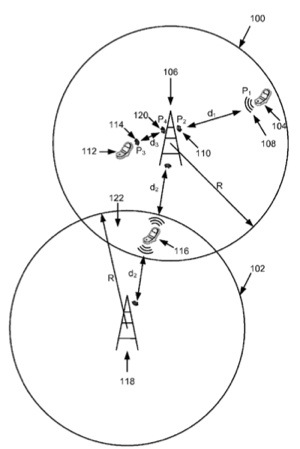Apple is looking into ways of improving the robustness of a wireless communication link, according to a new patent (number 20110143805) at the US Patent & Trademark Office. The patent is for a method and apparatus to improve the robustness of a wireless communication link between a base station and a mobile communication device.
The method increases power selectively on portions of an uplink communication signal transmitted from the mobile communication device to the base station. The method monitors a quality metric value at the mobile communication device and sets the transmit power level of the first portion of an uplink communication signal to the first power level, if the monitored quality metric value is in a first range of quality values, or sets the transmit power level of the first portion of the uplink communication signal to a second power level, if the monitored quality metric value is in a second range of quality values.
The first portion of the uplink communication signal includes control signals used by a base station to maintain connection of the wireless communication link. The inventors are Venkatasubramanian Ramasamy, Giri Prassad Deivasigamani, Srinivasan Vasudevan, Mohit Narang, Longda Xing and Johnson O. Sebeni.
Here’s Apple’s background and summary of the invention: “Mobile communication devices can communicate with a base station using one or more different protocols under varying communication link conditions. Communication signals received by the base station can be attenuated significantly by radiated power dissipation as the distance to the mobile communication device increases. This signal attenuation can increase susceptibility of the received communication signals to noise interference.
“Communication protocols typically divide the communication signal into portions that contain user generated data and supplemental information used for control of the communication link. Certain portions of the communication signal can be more important than other portions of the signal for controlling and maintaining integrity of the communication link between the base station and the mobile communication device.
“Corruption of the control portions of the signal can disrupt the communication link; thus it is desirable to guarantee high quality reception of the control portions of the signal. Increasing the power transmitted for the communication signal can increase the signal strength relative to interference and noise; however, communication protocols can set limits on the maximum power radiated by mobile communication devices in order to restrict total radio frequency energy absorbed by a user or to minimize radio interference between the mobile communication device and other devices using the same radio frequency bands. Thus there exists a need for a method for improving the robustness of a wireless communication link within the limitations of the total transmitted power of the mobile communication device
“This paper describes various embodiments that relate to methods and apparatus to improve robustness of a wireless communication link between a base station and a mobile communication device. A method and an apparatus adapted for the method that increases transmit power selectively on portions of an uplink communication signal transmitted from the mobile communication device to the base station are described.
“In one embodiment, a method for improving robustness of a wireless communication link between a mobile communication device and a base station is described. The method can be carried out by adapting transmit power levels of the mobile communication device in accordance with a quality metric value associated with the wireless communication link. The method can comprise monitoring the quality metric value at the mobile communication device, and adaptively setting a transmit power level of a first portion of an uplink communication signal transmitted on the wireless communication link from the mobile communication device to the base station in accordance with the monitored quality metric value.
“In an embodiment, if the monitored quality metric value is in a first range of quality values then the transmit power level of the first portion of an uplink communication signal is set to a first power level value. If, however, the monitored quality metric value is in a second range of quality values, then the transmit power level of the first portion of the uplink communication signal can be set to a second power level value. The second transmit power level value can be greater than the first transmit power level value, thereby improving the robustness of the wireless communication link.
“The method can repeatedly monitor the quality metric value and adaptively set transmit power levels in accordance with the monitored quality metric value while the wireless communication link is connected. Furthermore, the first portion of the uplink communication signal can include control signals used by a base station to maintain connection of the communication link with the mobile communication device.
“In a further embodiment, the method can adaptively set a transmit power level of a second portion of the uplink communication signal in accordance with the monitored quality metric value. The transmit power level of the second portion of the uplink communication signal can be set to the first power level value, if the monitored quality metric value is in the first range of quality values, and to a third power level value, if the monitored quality metric value is in the second range of quality values.
“The third power level value can be less than the first power level value. In some embodiments, the total average transmitted power can be balanced across the first portion of the uplink communication signal using the second power level value and the second portion of the uplink communication signal using the third power level value.
“In another embodiment, an apparatus is described that can improve the robustness of a wireless communication link between a mobile communication device and a base station. The apparatus can include a processor for monitoring a quality metric at the mobile communication device, and if the monitored quality metric is in a first range of quality values, setting the transmit power level of the first portion of an uplink communication signal to the first power level. If, however, the monitored quality metric is in a second range of quality values, then the transmit power level of the first portion of the uplink communication signal can be set to a second power level. In the described embodiment, the monitoring and the setting can continue while the wireless communication link is connected.”
Three other Apple patents have also appeared at the US Patent & Trademark Office.
Patent number 20110145004 involves bitrate constrained variable bitrate audio encoding. Per the patent, a hybrid audio encoding technique incorporates both ABR, or CBR, and VBR encoding modes. For each audio coding block, after a VBR quantization loop meets the NMR target, a second quantization loop might be called to adaptively control the final bitrate.
That is, if the NMR-based quantization loop results in a bitrate that is not within a specified range, then a bitrate-based CBR or ABR quantization loop determines a final bitrate that is within the range and is adaptively determined based on the encoding difficulty of the audio data. Excessive bitrates from use of conventional VBR mode are eliminated, while still providing much more constant perceptual sound quality than use of conventional CBR mode can achieve. The inventors are Shyh-Shiaw Kuo, Hong Kaura and William G. Stewart.
Patent number 201101045863 is for pushing a graphical user interface to a remote device with display rules provided by the remote device. It’s for a graphical user interface (“GUI”) can be presented on a remote control accessory device that has user input and display devices. The GUI can be defined and managed by a portable media device that is controlled using the GUI. The portable media device can provide the accessory with a GUI image to be displayed.
The accessory can send information to the portable media device indicative of a user operation of an input device in response to the displayed image. The portable media device can process this input to identify the action requested by the user and take the appropriate action, which can include updating the GUI image provided to the accessory. The inventors are Thomas M. Alsina, Szu Wen Huang, William Bull, Anthony M. Fadell, Jesse Lee Dorogusker, Emily Clark Schubert and Shyam S. Toprani.
Patent number 20110141276 is for proactive security for mobile devices. Per the patent, a mobile device can proactively determine whether the mobile device is associated with a security risk and the level of the security risk. Upon determining a security risk, the mobile device can transmit coordinates of its current geographic location to a server. To protect privacy of authorized users, the transmission can be disabled by entering a password. If multiple failed password attempts are detected, the mobile device can proactively increase a security level of the device, and selectively protect files or other content stored on the mobile device.
In some implementations, the mobile device can be transitioned into a surveillance mode where the mobile device records or captures information associated with one or more of user actions, ambient sound, images, a trajectory of the device, and transmits the recorded or captured information to the network resource. Hooman Borghei is the inventor.
— Dennis Sellers




